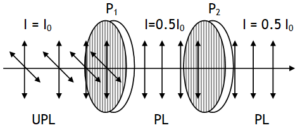^Malus law
^Malus law
Let I0 be the intensity and ‘A’ the amplitude of the unpolarized light falling on the polarizer & θ be the angle between the pass axis of the polaroid & amplitude vector, then the component Acosθ, parallel to the pass axis (y) of polarizer passes through it & the component Asinθ, perpendicular to pass axis is blocked by the polarizer, thus the intensity of light transmitted by the polarizer is


I = k (A cosθ)2 = k A2 cos2 θ
or I = I0 cos2 θ [called Malus law
Actually the phase angle for a beam of unpolarised light can have any value from 00 to 3600. Now as the average value of cos2 θ for the range 00 to 3600 is 0.5, thus the average intensity of light transmitted by a polarizer is only 0.5 I0. Following observations can be explained on the basis of Malus law.
1. Two polarizes with parallel pass axis (y & y)

2. Two polarizes with crossed pass axis (y & z)

